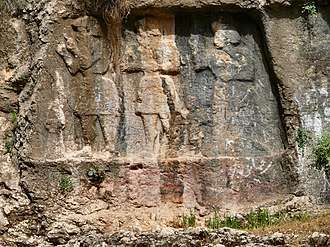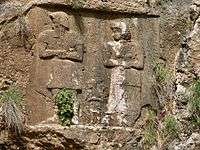Eshkaft-e Salman
Eshkaft-e Salman, or Shikaft-i Salman, is a cave with four reliefs, dated to circa the 12th century BCE, inside and outside the cave on the south of the Izeh, near the city in Khuzestan, southwest Iran.

Description
A well preserved 36-line cuneiform inscription stands to the left of the figure in relief IV.[1] In relief I a line of two men, a child and a woman face an incense burner or altar, while relief II shows a man, a child and a woman facing to the left. In both reliefs the men wear helmets of characteristic Elamite type, and plaits of hair are hanging down to their shoulders. Reliefs III and IV are now in very bad condition, but Layard described them in some detail. In relief III he recognized that the figure has its arms elevated and its hands joined in the attitude of prayer; a tunic descends to its knees; its head-dress is similar to that of the other figures. Layard thought that an inscription had existed to the left of this figure, and suggested that water percolating through the rock has completely effaced it. He also recognized a fragmentary cuneiform inscription on the figure’s dress. About the figure in relief IV Layard noted that it has a long robe descending to its ankles; its arms appear to have been folded on its breast. The beards descend in curls almost to the breast, and the head-dress resembles that worn by the priests of the Magi. It appears to consist of a cap fitted close to the head, and advancing in a double fold over the forehead. The dress of this figure was also inscribed with a cuneiform inscription, and only to the left of this figure did Layard find the above mentioned cuneiform inscription. The style of the figures in all four reliefs seems to indicate a date in the 12th century BCE, but the inscriptions are of the time of Hanni. It is therefore thought that the inscriptions were added by Hanni at a later date.[1]
Outside the cave, there is a ruined building and a small cave, local people believe that the building belonged to the Salman the Persian and has been his prayer place but it is perhaps from the Atabaks period.[2]
Gallery
 Eshkaft-e Salman II,The picture of a woman with dignity shows the importance of woman in Elamite era [2]
Eshkaft-e Salman II,The picture of a woman with dignity shows the importance of woman in Elamite era [2]- Eshkaft-e Salman III
- Eshkaft-e Salman IV
 Diagram of reliefs III and IV
Diagram of reliefs III and IV
III is the right one and IV is the left relief
See also
References
- Curtis, John. "LAYARD, Austen Henry". Encyclopedia Iranica. Retrieved 2011-07-09.
- Atlas of Eshkaft-e Salman (In Persian)
Further reading
- Potts, D.T. (1999). The Archaeology of Elam. Cambridge: Cambridge University Press. ISBN 0-521-56358-5.
External links
| Wikimedia Commons has media related to Eshkaft-e Salman. |
- Atlas of Eshkaft-e Salman (In Persian)
- List of Elamite Rock Reliefs (Livius.Org)
